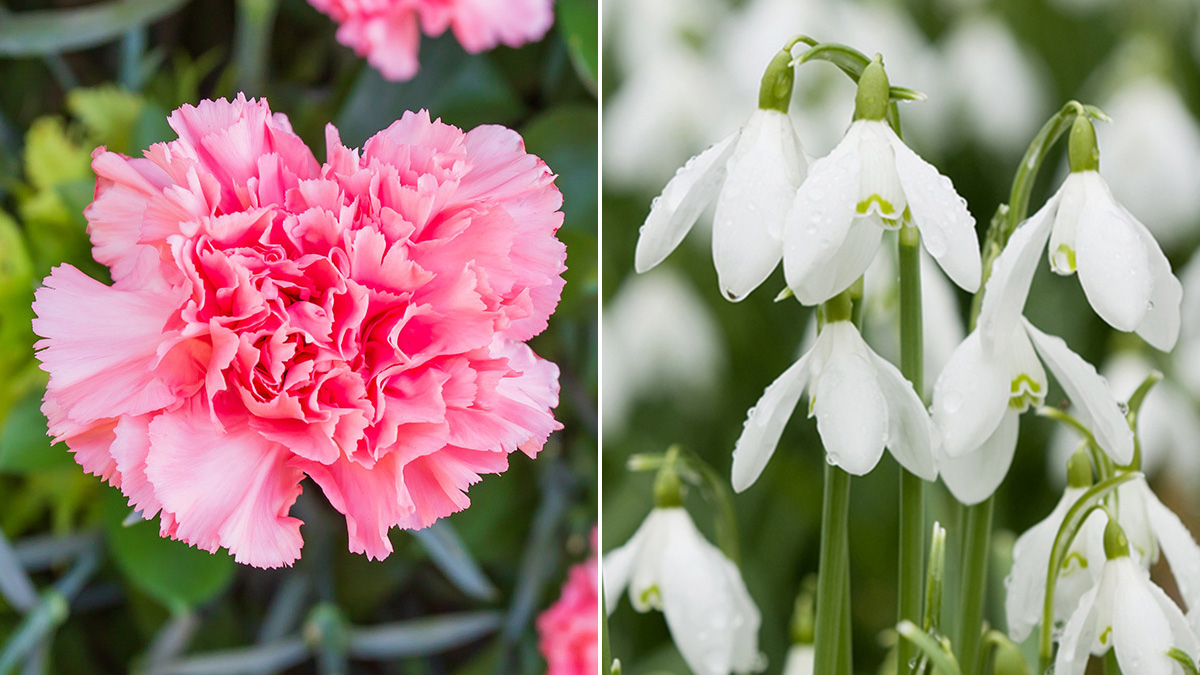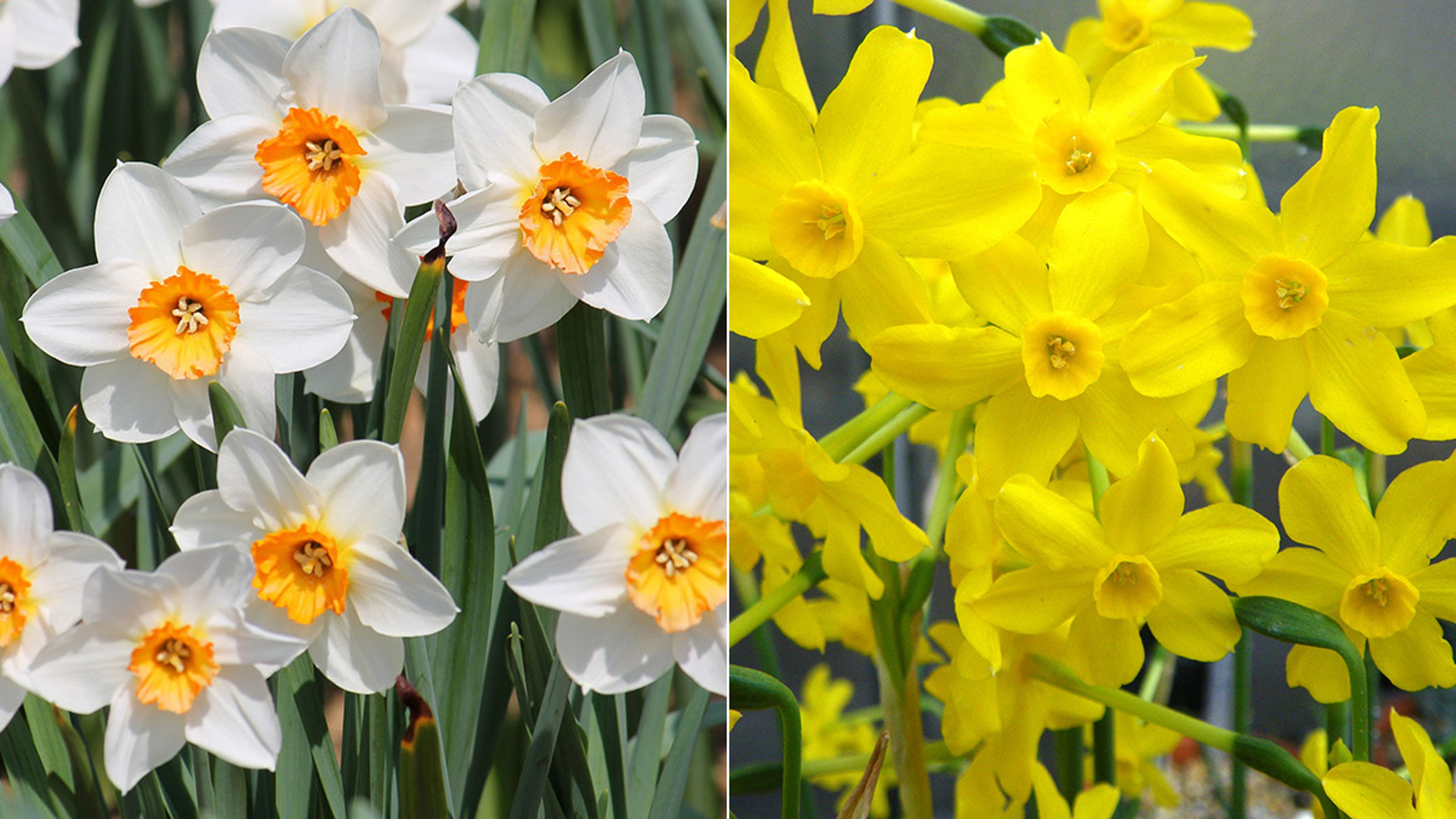January Birth Flowers: All About the Carnation & Snowdrop
These two magnificent blooms usher in winter while still providing hope that springtime is near.
Dec 06, 2023
As January unfolds, bringing with it the frosty charm of winter, it introduces us to the month's two birth flowers. These blooms, each possessing a unique allure, add a touch of grace to the season — whether they are adorning a winter garden, enhancing a bouquet, or serving as tokens of love and appreciation.
Standing as symbols of enduring beauty, hope, and elegance, these two examples of floral excellence transcend the chill of winter and herald the promise of renewal in the approaching spring. So, as we embrace the coldest month of the year, let's acquaint ourselves with the January birth flowers and what makes them so special.
What are the January birth flowers?
The January birth flowers are the carnation and snowdrop.

Carnations (Dianthus caryophyllus) are known for their frilly petals and sweet fragrance. They come in a spectrum of colors, including white, pink, red, purple, and even green. Their ruffled appearance, spicy-sweet scent, and long, sturdy stems make them a favorite for floral arrangements and bouquets. Due to their versatility and durability, carnations are used in variety of settings, from formal events and weddings to everyday occasions, and frequently show up in boutonnieres and corsages.
Snowdrops (Galanthus) are petite, bell-shaped flowers with pristine white petals. They bloom in late winter to early spring, sometimes even pushing through the snow, hence their name. Snowdrops are generally small, reaching heights of 3 to 6 inches, and typically grow in clumps or clusters. They naturalize easily, spreading over time, and can form extensive colonies.
What is the history of carnations?
Carnations date back over 2,000 years. They are believed to have originated in the Mediterranean, and were first cultivated by the Greeks and Romans, who used them in art and ceremonies, and even as medicinal remedies. (The genus name Dianthus is derived from the Greek words dios, meaning "divine," and anthos, meaning "flower.")
From there, carnations were introduced to Asia, particularly China and Japan, where they became popular and were cultivated for their aesthetic appeal.
In the Middle Ages, monks grew carnations in monastery gardens for both medicinal and decorative purposes, and during the Elizabethan age, carnations were prized for their fragrance, often being used in potpourri.
What does the carnation mean?
Generally, carnations are associated with fascination, love, and affection. They also have more specific meanings depending on their color.

Here's the breakdown:
- Red: Admiration
- Deep red: Romantic love
- Pink: Gratitude
- White: Purity and friendship
- Yellow: Sorrow
- Purple: Royalty
Carnations, particularly pink and red ones, have a strong association with Mother's Day, and because of that, they also symbolize a mother's love. Additionally, due to their long-lasting blooms, carnations have become synonymous with enduring love.
How to care for carnations
Most carnations require little more than basic flower care. This guide will help you plant, grow, and care for your carnations.
- Soil: When planting carnations,choose a well-drained soil with a slightly alkaline to neutral pH.
- Sunlight: Plant carnations in an area that receives full sun for at least 4 to 6 hours a day.
- Watering: Keep the soil consistently moist but not waterlogged. Water the plants at the base to avoid wetting the foliage, which can lead to fungal issues. Water deeply when the soil feels dry to the touch, especially during dry spells.
- Fertilization: Feed carnations with a balanced, all-purpose fertilizer during the growing season (spring to early fall).
- Deadheading: Regularly remove spent flowers to encourage continuous blooming.
- Pruning: Trim the plants lightly, cutting back by about one-third, after the first flush of blooms to promote bushier growth.
- Winter care: In regions with cold winters, apply a layer of mulch around the base of the plants to protect them from freezing temperatures. Consider bringing potted carnations indoors or providing additional protection if extreme cold is expected.

3 interesting facts about carnations
- The green carnation is one of the most iconic flower symbols in LGBTQ+ history. Legendary gay playwright Oscar Wilde asked actors and friends to wear green carnations at the opening night performance of his play "Lady Windemere's Fan" in 1892; subsequently, Parisian gay men began wearing green carnations in public to send a message to other men that they were gay.
- In Victorian times, striped or variegated carnations were sometimes associated with a refusal or message that conveyed "I cannot be with you."
- The Carnation Revolution took place in Lisbon, Portugal, on April 25, 1974, resulting in the country's transition from a dictatorship to a democracy. The event got its name from the fact that demonstrators, while celebrating the overthrow of the authoritarian government in the streets, distributed carnations to soldiers.
What are the best January birth flower gifts?
These enchanting gift options highlight everything we love about the January birth flowers.
What is the history of snowdrops?
Snowdrops are native to parts of Europe and Asia, and have been growing in the wild for centuries. They are believed to have originated in the eastern Mediterranean region and parts of the Middle East.
In the 17th century, they became more popular in European gardens, especially in England. During the Victorian era, they were featured in "Language of Flowers" books as symbols of hope and consolation.
Snowdrops were introduced to North America in the 19th century and have naturalized in some regions, particularly in the northeastern part of the continent.
What does the snowdrop mean?

With their ability to bloom early and appearance marking the arrival of spring, snowdrops are often seen as symbols of hope and rebirth. Their pristine white petals also call to mind purity and innocence; in some cultures, they are even associated with the Virgin Mary.
Snowdrops are hardy flowers that can withstand cold temperatures and even bloom in snowy conditions and, thus, are associated with strength and the capacity to overcome challenges. As symbols of remembrance, these flowers are often planted in cemeteries and memorial gardens.
Snowdrops have symbolic roots in different religions too. In Christianity, they are sometimes referred to as "Candlemas bells" because they often bloom around the time of the Candlemas festival (on Feb. 2), which marks the presentation of Jesus at the Temple in Jerusalem. In pagan traditions, snowdrops are associated with the festival of Imbolc, a celebration of the halfway point between the winter solstice and the spring equinox.
How to care for snowdrops
Caring for snowdrops is relatively straightforward, as these resilient and low-maintenance flowers are adapted to colder climates. Follow these tips for the best results.
- Planting: Plant snowdrop bulbs in late summer to early fall, in well-drained soil that is rich in organic matter.
- Sunlight: Snowdrops thrive in partial to full shade. Plant them in locations where they receive dappled sunlight or filtered light from deciduous trees.
- Soil: Ensure the soil is consistently moist but well-drained. Improve soil drainage by adding organic matter, such as compost or well-rotted manure, to the planting area.
- Watering: Water newly planted bulbs thoroughly to help them establish roots. After that, snowdrops are generally drought tolerant and require minimal watering.
- Mulching: Apply a layer of mulch, such as straw or bark, around the snowdrops to help retain soil moisture and suppress weed growth.
- Deadheading: Deadhead spent flowers to redirect energy back into the bulbs and prevent the plant from putting energy into seed production.
- Winter protection: While snowdrops are cold hardy, providing some protection during the winter can be beneficial. Mulch can help insulate the soil and protect the bulbs.

3 interesting facts about snowdrops
- Snowdrops have a dedicated following of enthusiasts known as "galanthophiles," who collect and cultivate various snowdrop varieties.
- Snowdrops contain substances known as alkaloids, and all parts of the plant are considered toxic if ingested.
- A single snowdrop bulb called "Golden Tears" sold in 2022 on eBay for a record-setting sum of more than $2,300!





















